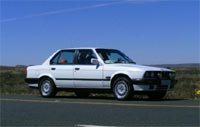I mean what constitutes 'true value' when it comes to buying (or selling) a car? In fact why do we buy a new car at all?
Ladies please come in! You are most welcome. This is by no means the preserve of men only. Some of the best mechanics and racing drivers have been women, and on the road there are as many women drivers as men.
Do we buy new for reasons of status and good looks? A fresh Motor Plan? Better reliability? Improved safety? High performance?
What are the facts? Well my vehicle has covered nearly 370,000 kilometres, looks virtually in showroom condition, interior and exterior, been re-valued at twice it book value and is arguably more reliable than a new vehicle. Admittedly I've spared no expense maintaining it in mint condition.
Environmentally speaking scrapping the vehicle makes little sense, as it simply places more stress on the environment. Buying a new 'environmentally-friendly' car may give me 5 litres per 100 kilometres better fuel consumption. True. But it places an even greater stress on the environment. I would have to drive thousands of kilometres for the improved fuel consumption to compensate for the carbon footprint caused by its manufacturing process! One advantage of buying a new car does lie in improved safety standards, such as airbags etc. Older cars do not have this feature. But their relative safety often lies in their heavier, more solid build.
Look at it this way - would you want to spend R250k on a new car? Or would you prefer to spend R40k on a used car which has been maintained at such a high level that it is functionally a new car, and save R210k?
Confused? Then let me unpack this a little more.
Let's get back to value ... Currently I am reluctant to sell my car even above its market value. Why? In fact what creates this value?
The answer lies in intelligent maintenance and the skilled support of craftsmen. These skills not only restore cars and components to literally as new condition, they restore our faith in a world obsessed by obsolescence.
True craftsmanship exists when value resides in the specific expertise offered by the craftsman. At best, pride in workmanship and hard work take priority over hard cash. Paradoxically this level of professional integrity creates real wealth for the craftsman.
When greed and opportunism take over, businesses invariably lose reputation and market share.
In a money-obsessed world it's too easy to forget that true value resides more in people than in products. 'That's obvious' some may say; but 'common cents' is not so common in today's world.

Take a look at this 1991 BMW 318i on a country-wide road trip in flawless, 'as new' condition.
Every square millimetre of this vehicle has been maintained and restored by a team of dedicated craftsmen, and they're equally available to you as they are to me.
Having rebuilt many worn and damaged engines, gearboxes and components with my own hands, permit me to put under a microscope the deterioration that takes place when you actually operate your car, and how this can be countered.
Every time you enter and run the machine, virtually every element undergoes wear and tear, especially at an atomic level. Admittedly it takes a high mileage for wear and tear to manifest, but manifest it will!
For the moment let's ignore solar damage to bodywork, wear and tear on seats, tyres, hand controls, as well as constant deterioration of steering, transmission, suspension, clutch and brake systems.
Let's take a look at the engine alone.
Every time your engine runs, countless surfaces rub against each other and millions of atoms of metal get shed in the process. This metallic 'powder' contaminates the oil on an increasing scale. If the oil is not changed regularly, this abrasive mixture causes exponential engine wear, drastically reducing what engineers term 'mean time to failure'. The same happens in the gearbox, the differential and wheel bearings, albeit on a more gradual scale.
Engine oil is designed to do three things: to cool, to clean and to lubricate. Clean oil minimises metal to metal contact (and wear) on all moving parts, but this is only optimised once the engine is hot.
Consequently 90% of an engine's wear and tear occurs, believe it or not, during the first few minutes following start-up from cold. This is because much of the oil has drained back into the sump and it takes a few critical seconds to re-circulate and protect the engine. This is the phase during which most of the engines wear takes place. Additionally, to enable the cold engine to run smoothly, the fuel mixture is initially enriched (remember the choke?) and this further dilutes the protective action of whatever oil remains in the cylinders. After a few hundred thousand kilometres the piston rings will wear and the car will start to smoke.
When I asked one Jacobsdal farmer how his Izuzu bakkie managed to reach 600,000 kilometres without an engine overhaul, he replied: "My bakkie word nooit koud nie!" His engine simply never got cold! Apart from daytime activities, he regularly drove his bakkie to activate pumps and do security checks at various intervals throughout the night.
The moral? Change your oil frequently, even more frequently than recommended by the handbook.
I'm a little obsessive about clean oil and have consistently exceeded the manufacturer's service recommendations. This includes engine, gearbox and differential. It doesn't cost much, yet it does wonders for long engine life and healthy performance.
In terms of years and mileage my BMW is an 'old' vehicle. Yet if you were to drive this car, you could be forgiven for thinking you were driving a new vehicle! Clean oil is only part of the solution.
The real secret? Craftsmen!
These are men and often women who are highly experienced, highly skilled and highly conscious of their area of specialisation.
As a vehicle owner, provided you have an adequate understanding of the various wear and tear areas, and know when to take your car to a specific craftsman, you will drive and maintain your car 'as new' indefinitely.
In terms of money, intelligent maintenance can cost a fair amount, but certainly nowhere near the cost of buying a new car. And remember the motor plan, on which owners place such importance, only covers your car during the early phase of its life when wear and tear is hardly an issue!
I believe in pro-active maintenance (why wait for a breakdown?) and have consistently taken my car to specific craftsmen at specific times in my vehicle's life and the result is a car that today, nearly a quarter of a century later, truly runs and feels like a brand new car.
In fact it is more powerful and arguably more reliable than when it gently rolled out of the showroom floor!
This is because intelligent maintenance and restoration has endowed the engine with more power and reliability than the original vehicle. This is a car that has been tempered by life, all teething problems eliminated and additional reliability built into the system by dedicated craftsmen. Integrity and workmanship are their guarantee, not the small print in the dealers' documents.
Not only is my BMW more powerful; it runs quietly and surprisingly smoothly. This is because most of the chassis and suspension rubbers have been replaced. These normally harden from heat and vibration over time and impart a hard, almost rough road feel to an older car.
Here are the craftsmen that, as a team, have maintained my vehicle in as-new condition:
New bearings, oil pump, pistons, renovated cylinder head (280,000km), water pump (100,000km), fuel pump (250,000 km), reground camshaft (250,000km), overhauled starter motor and alternator including brushes and bearings (320,000km), gearbox and engine mountings (300,000km), gear-lever bushes (340,000km), new clutch and brake master/slave cylinders (230,000km), new brake discs and wheel bearings (310,000km) and so much more. Admittedly he sent certain components to other specialists (camshaft regrinders, auto-electricians etc). These are craftsmen in their own right.
Some may say I've overcapitalised on a car with a low book value. What is book value anyway? Who determines that? At best book values are arbitrary. At worst they are criminally low.
I now have a vehicle able to take me anywhere in the country and back - smoothly, economically, swiftly, silently, reliably - in fact it is functionally as good as any new car. Over recent years I may have spent over R50k in restoration costs, but I have saved literally hundreds of thousands of rands which a new car of equivalent performance and feel would have cost me!
Additional benefits? No motor plan required. No monthly repayments due. Low all-risk insurance premiums. Low maintenance costs. All parts readily available. Low theft potential. High performance. Excellent economy. Solid reliability and 'classic' good looks. And the strange satisfaction that one gains from restoring an object of quality.
Now if I so choose, I am able to sell the vehicle at twice its book value and upgrade to another used vehicle, one equally maintained by craftsmen.
To conclude, the secret is to invest in proven craftsmen and master mechanics, a skilled breed of specialists who are rapidly disappearing in our robotised, over-mechanised, mass-produced, de-humanised world. May they live and prosper forever!
